MCE standby Tool
Les options de configuration peuvent être utilisées directement, sans installer le programme. Sélectionner quelle veille vous voulez utiliser. Les options avancées ne sont pas encore utilisables, elles sont grisées. Pour utiliser ces options l'outil doit être installé. Pour ce faire cliquer sur l'onglet Install et sur Install MST.
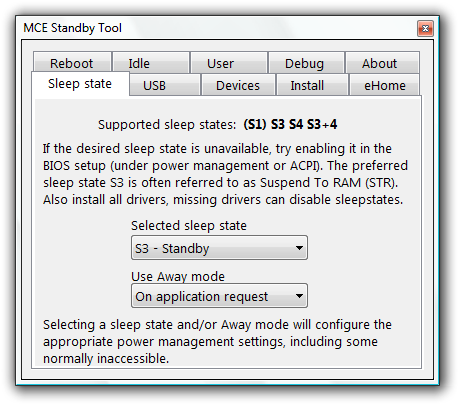
Ce sont les états de veille actuellement pris en charge par le système.
Cette liste peut être utilisée pour vérifier que le système supporte la
veille (S3). Dans le cas où il n'apparaît pas sur la liste, sur la plupart
des cartes mères modernes il est possible de permettre la mise ne veille
dans la configuration du BIOS. Rechercher l'option appelée quelque chose
comme "Suspend to RAM", "STR" ou "ACPI S3", activez-le ou sélectionnez S3. Selected sleed stateSelect the desired sleep state here. MST will make the appropriate power management
settings and create an Administrator override (like the MS tool dumppo.exe)
when required so the system will use the selected sleep state. Use Away modeSelect if- and how the system will use the Away mode.

Enable USB S3 resumeChecking this will enable USB devices to resume the system from standby. For example the Microsoft remote requires this to bring the system out of standby. This should be checked on almost every MCE system. In case the system wakes directly after putting it to sleep, uncheck this option to see if a USB device causes it.Once "Enable USB S3 resume" is enabled the device manager will show the option "Allow this device to bring the computer out of standby" for the USB devices that can wake the system. Windows Vista does not have the ability to disable USB S3 resume. Disable selective USB suspendDisabling selective USB suspend might help with devices that cause problems when resuming from standby. The power consumption of some USB devices might increase slightly.USBBIOSHACKSThis option is officially not supported and Microsoft advices not to use it. In practice it has proven to solve standby problems. On some systems checking this solves problems while on other machines it introduces problems. Try both situations to find out if it is useful for your problem.If USBBIOSHACKS solves your problem, please report the details to me. This way I would like to figure out what it exactly does. On Windows Vista USBBIOSHACKS does not have any function.

This is the list of devices that can wake the system from standby. Only select
the devices you want to use to wake the system. Network cards, (wireless) keyboards
and mice are usually responsible for unwanted resumes from standby. RefreshClick this button to refresh de list. This can be required after adding for example a USB device.

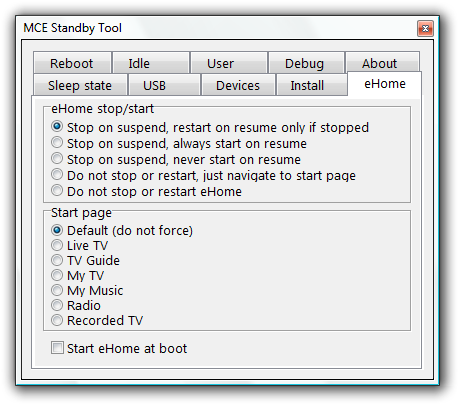
eHome stop/startAt the moment the system is put into standby, MST closes eHome (the actual Media Center application). If eHome is running when waking from standby to perform a automated task (scheduled recording or guide update) eHome often stops the PC from entering standby after this task is finished.A lot of XP MCE users experience this problem since the installation of the update rollup 2. The scheduled recordings and guide updates will continue normally, even when eHome is not active. Depending on the primary task of the system a different stop/start strategy can be chosen. After closing and before restarting eHome MST blanks the screen. Stop on suspend, restart on resume only if stopped (default)If eHome was running at the time of entering standby, it will be restarted when resuming.Stop on suspend, always start on resumeeHome will always be started at resume, no matter if it was running when entering standby. This is the preferred option for dedicated media center system. Users will never be confronted with an empty desktop, even after maintenance or reboots.Stop on suspend, never start on resumeThe system will always resume to an empty desktop. This can be useful when the systems is not primarily a media center.Do not stop or restart, just navigate to the start pageIf it is not requiered to stop eHome this option can be used to start eHome on a defined page when resuming.Do not stop or restart ehomeMST will not stop eHome when entering standby.Start LocationChoose which screen you want to start when resuming from standby.Start eHome at boot (off)Start the media center shell after booting the system.
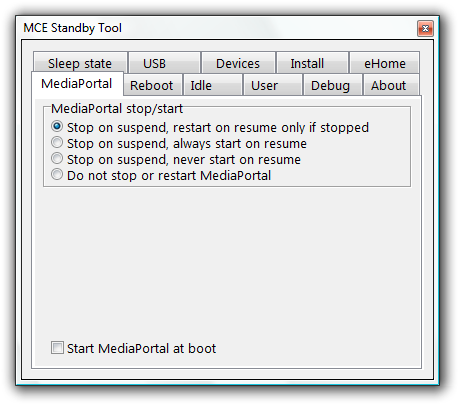
MediaPortal stop/startAt the moment the system is put into standby, MST closes MediaPortal. This might improve standby reliability on some systems. Depending on the primary task of the system a different stop/start strategy can be chosen.After closing and before restarting MediaPortal MST blanks the screen. Stop on suspend, restart on resume only if stopped (default)If MediaPortal was running at the time of entering standby, it will be restarted when resuming.Stop on suspend, always start on resumeMediaPortal will always be started at resume, no matter if it was running when entering standby. This is the preferred option for dedicated media center system. Users will never be confronted with a empty desktop, even after maintenance or reboots.Stop on suspend, never start on resumeThe system will always resume to an empty desktop. This can be useful when the system is not primary used as a media center.Do not stop or restart MediaPortalMST will not stop MediaPortal when entering standby.Start MediaPortal at boot (off)Start the MediaPortal application after booting the system.
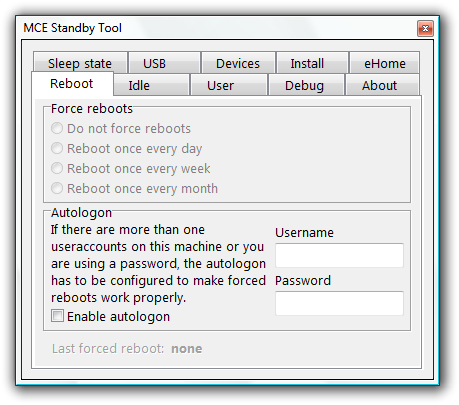
Force rebootsSelect if and how often your system will be forced to reboot. Running a Windows system for a long period sometimes makes it cranky or even unstable. A reboot now and then will give you a "fresh" system.When the systems returns to standby after an automated task (guide update or scheduled recording), MST checks if its time for a reboot. If so, it will cancel the standby process and force the system to reboot. When the system comes back up MST puts the system into standby. On most systems this means the reboot is done right after the guide update. Windows Vista does no longer have the ability to cancel the standby process. For this reason this option does not work on Vista. A different approach might be used in a future version of MST. AutologonWhen using forced reboots it is required that the system does not get stuck in the logon procedure. If you are using a password or multiple user accounts, configure autologon. Leave the "password" field empty when your account does not have a password. Be careful, the password will be stored in the registry unencrypted.
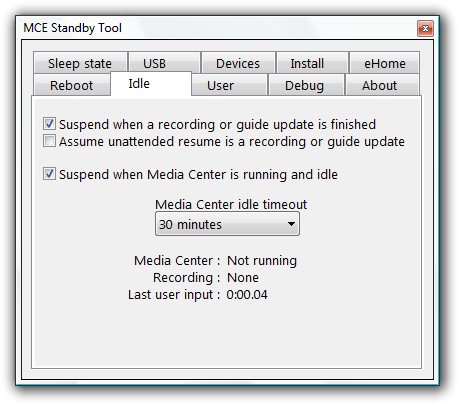
Suspend when a recording or guide update is finished (on)When the system awakes for an automated task (scheduled recording or guide update) it should return to standby after the task is finished. Unfortunately this is not happening in a lot of situations. By enabling this function MST will detect the task is finished and put the system standby anyhow.Assume unattended resume is a recording or guide update (off)When enabled MST treats a resume as a recording or guide update as long as no user activity is detected. This is very useful on systems that are unable to do automatic-resumes. (For example those using hibernate (S4) as sleep state).Do not use this when the system is used for remote tasks (remote desktop, WebGuide, file/printer server etc.). Suspend when Media Center is running and idle (on)The Windows idle detection is often not able to put a MCE system standby when it is not being used. When the media center application is running and not active being used, MST will detect this and put the system standby (after the selected time-out). The buffering of live TV will not stop this from happening, any running recording will be finished.Probably this does not function right when using an extender. Lack of an extender made it impossible to test. Media Center Idle timeout (30 minutes)This is the period the media center application has to be inactive before MST puts the system standby.

Suspend when Media Center is running and no user input (on)This option will put the system standby when there is no user detected (keyboard, mouse or remote activity) for a period of time. This can happen if the TV/monitor is switched off or the user is no longer present.User input idle timeout (2.5 hours)The period of user inactivity before suspending the system.

DebugThese options can be helpful when isolating the cause of standby problems. Here you can also find some options which still are in a experimental stage.Enable log options (unchecked)By checking this option, the file "MST Log.txt" will be generated on the desktop. The information in this file is very useful when investigating standby problems.Enable balloon tips (checked)After closing and before restarting eHome the screen will be blanked. Unchecking this will prevent the system from showing balloontips.Kill FPManager.exe at resume (unchecked)On some Intel barebone based systems (Paradigit Enjoy TV2005) this might fix a improper functioning display at resume.Disable Force USB enumeration (unchecked)Could possibly fix problematic USB devices at resume.Please report if this option is of any use. When there are no reports this option will be removed from MST. Standby delay (5 sec.)When te system enters standby, delay it for the selected time. This might solve problems which arise when resuming the system. If closing eHome manually works and closing it automatically does not, adding a delay might work. Increase it on slow systems (Athlon XP 2000+ and below).Caution: setting the Standby Delay too low (0 or 1 sec.) might cause missed recordings on XP MCE systems! Delay before starting eHome (0 sec.)Wait the selected time before starting eHome after resuming form standby. This might solve problems with starting eHome. For example the "Your video card or drivers are not compatible with Media Center" error.nVidia videocard standby fix (Disabled)This setting controls which low power state the video card uses during suspend. Selecting a different low power state might solve issues like black screens on resume.Logfile Location (desktop)Here the MST log files will be stored.

|